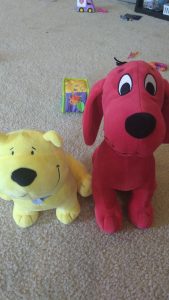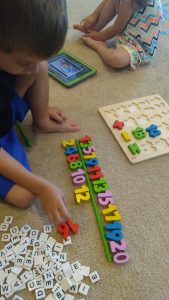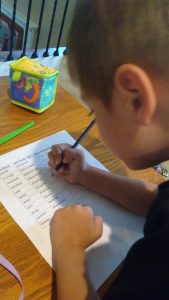I love doing prefix and suffix lessons with 5 year olds. They aren’t just lessons on prefixes and suffixes, although they are. They also teach character lessons when we are teaching words like being “careless” or “careful.” You can work through a lot of life’s sticky situations as you talk about whether or not it’s ok to “agree” or “disagree” with someone. If you’ve ever had an argument with a 5 year old over whether or not everyone is allowed to have a different favorite color than they do, you might see that these are powerful lessons. These show the power of an educative approach to dealing with children’s behavior.
My children largely kicked off these lessons. My oldest, for instance, took notice of how words were inside words. I once said a word with “less” at the end and gave the definition. Immediately after this, he unlocked our front door and said, “And now it is lockless!” Sure, this is wrong, but he picked up on the pattern. Time for more patterns.
I love these lessons because the prefix added to most words makes the opposite of the word, e.g., “able” versus “disabled.” I love teaching opposites. In Montessori, concepts are presented as opposites. Children are presented big versus small blocks; tall versus short cylinders, etc. It is a powerful teaching paradigm.
Most workbook style lessons on prefixes and suffixes were too complicated for what I wanted. For instance, one wanted the child to answer this question: in a sentence, should a word be “beautiful” or “beautiless”? I think this creates confusion. The child sincerely doesn’t know and might think you are tricking them.
I wanted something simple to demonstrate the idea first, without questions. I think most teaching today involves way too many questions and not enough demonstrations. So I ended up making my own lessons. I simply found words, which had corresponding prefixes and suffixes. We then acted them out. That’s why these are so fun. For worksheet work, I simply had them circle the prefix or suffix on a paper with the words printed out.
It helped me to know that of all the prefixes, 4 of them make up 97% of words. I don’t remember but I think they are dis-, un-, re-, and mis-.
“DIS” prefix
I printed out a sheet of paper with these words listed. We worked down the list, much to my children’s delight. The activities we did are below.
| appear | disappear |
| able | disabled |
| courage | discourage |
| arm | disarm |
| array | disarray |
| satisfied | dissatisfied |
| agree | disagree |
| connect | disconnect |
Appear versus Disappear
This one is super fun for the first lesson. Have the child leave the room and then “appear.” Then close your eyes and let them “disappear.” It hints at the meaning of “dis”: we first had something and now we don’t.
Able versus Disable
Another easy one to start with. Have them walk across a room. They are able to do this. Then pretend their foot or leg is broken. They are now disabled. They again had something at first, ability, and now they have lost it.
Courage versus Discourage
Now we are starting to get serious with these lessons. I set up some “monsters” who were protecting a treasure. These were our monsters:
My children needed “courage” to fight through the monsters to get the treasure. Then, oh no, one of the monsters was going to bite us! Your children probably won’t want to do this. I had to do it. After being bit, you have become discouraged.
I really enjoyed doing this with my children, because we worked through conflict. My son came over to me to say, “Mommy I will help you. I am drawing all the strength to my brain. I know! Fast! I’ll go fast to get the block!” My heart. Seriously.
My daughter was deathly afraid to be bit by the monsters. And this is something we dealt with all the time with her. She is very afraid of anything approaching her too quickly, etc. She starts screaming. I told her she didn’t have to do it, but she insisted on doing it. When she was “discouraged,” her brother came up to her quickly. I got really mad at him. But then I found out he was trying to hug and comfort her. So now I know what “comforting” looks like to him: it’s a bit rough and fast, but his intentions are good. Knowing this helps me for future conflict

Armed versus Disarmed
For this, pick up a “weapon.” You are armed. Now drop it or knock it out of their hand (if they find it fun). You are now disarmed. Again: “dis” is something we used to have but now it’s gone.
Array versus Disarray
This one is way fun and powerful educationally. An array is “something arranged beautifully.” It can be anything. So pick at least two things to arrange. You could put letters in alphabetical order, numbers in some kind of order, or colors in rainbow order. Then let your child make other “arrays.” This is a wonderful clue to their personality. My son, at 5, put numbers in even and odd order:
My daughter on the other hand put nearly everything in rainbow order. Here are some of the arrays we worked on:

To teach “disarray,” we then messed up the things we had put in order.
Satisfied versus Dissatisfied
This one was hilarious. I asked my children to draw pictures that I would be satisfied with and then dissatisfied. And they went to work drawing something they knew their mother would disapprove of. Ha. It seriously was very funny. My son, 7, drew a well drawn T Rex who brushed his teeth. Then he drew a poorly drawn T Rex who farts. It’s funny! My daughter drew a beautiful then “ugly” flower.

Agree and disagree and connect and disconnect are pretty intuitive. The only thing I had them do on a worksheet was circle the prefix when done.
“UN” Prefixes
These are the “un” prefixes we did
| Lock | Unlock |
| Cover | Uncover |
| Tie | Untie |
| Wrap | Unwrap |
How to do each of these is probably pretty intuitive. For “wrap,” you might want to be prepared with some wrapping paper and something to wrap. It is super fun to wrap and unwrap things with children.
“Re” Prefixes
| appear | reappear |
| trace | retrace |
| arrange | rearrange |
| use | reuse |
| tell | retell |
| do | redo |
Again, these are pretty intuitive. We also did a few “mis” prefixes. Misstep and misunderstand are fun.
“ER” Suffix
The “er” suffix takes a verb and creates an occupation. Simply talking about them is sufficient.
| Sing | Singer |
| Work | Worker |
| Fight | Fighter |
| Teach | Teacher |
“FUL” and “LESS” Suffix
| color | colorful | colorless |
| fear | fearful | fearless |
| thank | thankful | thankless |
| hope | hopeful | hopeless |
| care | careful | careless |
| harm | harmful | harmless |
| thought | thoughtful | thoughtless |
| help | helpful | helpless |
We did ful/less with a colorful butterfly and then a colorless one. The rest of them are great character lessons. After these lessons, I pointed them out in real life. I once grabbed a wrong sock. I said, “I was careless!”
Growth the Misbehavior is Growth way
If you’ve read my Misbehavior is Growth series, you know I don’t do “discipline.” I seek to not change my children but rather give their natural forward moving growth wings. These lessons show how you can use education itself for conflict resolution and character growth.
These lessons are less so children knows the definition of “prefix” or “suffix” but so they can use patterns to figure out future words. They really enjoy this type of pattern finding. And we’re learning words!
It’s impressive when you see your child use what they learned in their everyday life to communicate, figure out problems, or self improve. For instance, my son once carried a bowl and spilled some liquid. He said, “I should be more careful next time! Hey! If I am always careful, I won’t spill things!” I don’t *ever* say to him “Be careful,” instead it’s a skill we work on–and to see it live, I mean …. it’s why I do it!
See my book series at the top of this webpage and come join me on the social media stuff as “The Observant Mom”!


